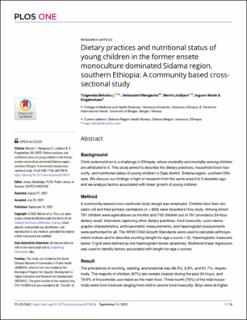| dc.description.abstract | Background: Child undernutrition is a challenge in Ethiopia, where morbidity and mortality among children are attributed to it. This study aimed to describe the dietary practices, household food insecurity, and nutritional status of young children in Dale district, Sidama region, southern Ethiopia. We discuss our findings in light of research from the same area 3 to 5 decades ago, and we analyze factors associated with linear growth of young children.
Method: A community-based cross-sectional study design was employed. Children less than two years old and their primary caretakers (n = 903) were included in this study. Among whom 791 children were aged above six months and 742 children out of 791 provided a 24-hour dietary recall. Interviews capturing other dietary practices, food insecurity, socio-demographic characteristics, anthropometric measurements, and haemoglobin assessments were performed for all. The WHO Child Growth Standards were used to calculate anthropometric indices and to describe stunting (length-for-age z-score <-2). Haemoglobin measures below 11g/dl were defined as low haemoglobin levels (anaemia). Multilevel linear regression was used to identify factors associated with length-for-age z-scores.
Result: The prevalence of stunting, wasting, and anaemia was 39.5%, 3.9%, and 61.7%, respectively. The majority of children (97%) ate cereals (maize) during the past 24 hours, and 79.6% of households use maize as the main food. Three fourth (75%) of the total households were food insecure ranging from mild to severe food insecurity. Boys were at higher risk of having lower length-for-age z-score than girls (β -0.53; 95% Confidence Interval (CI): -0.78, -0.27). For each month the children grew older, length-for-age z-score decreased slightly (β -0.06; -0.07, -0.04). Household food insecurity scores (β -0.05; -0.08, -0.01) and children haemoglobin levels, (β 0.21; 0.06, 0.35) were also associated with length-for-age z-score among young children.
Conclusion: Linear growth failure (stunting) was prevalent among young children in the rural Sidama region and the majority of them were also anaemic. Older age, male sex, a lower haemoglobin level in children, and household food insecurity were risk factors of linear growth failure in young children. Maize seems to be the dominant food in this previously ensete dominated area; however, there have been minimal improvements in length-for-age z-score over decades. Strategies to ensure household’s food access and improve the quality of child diets need to be implemented. | en_US |

